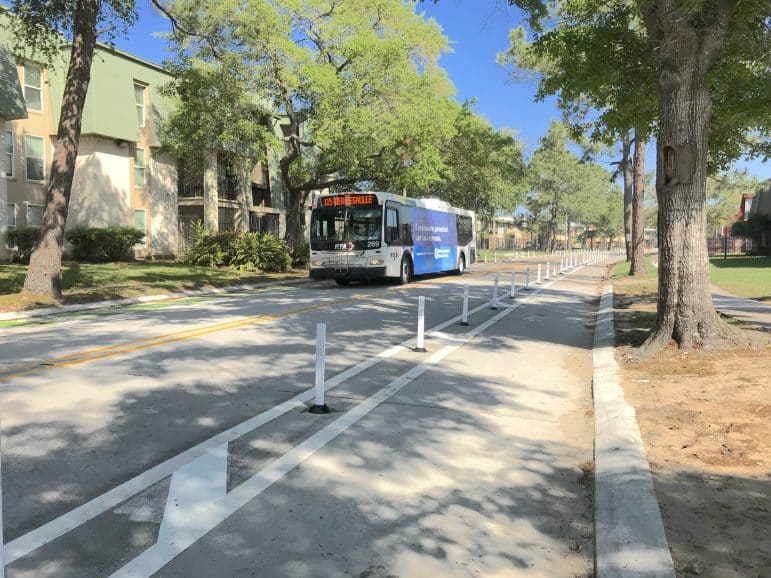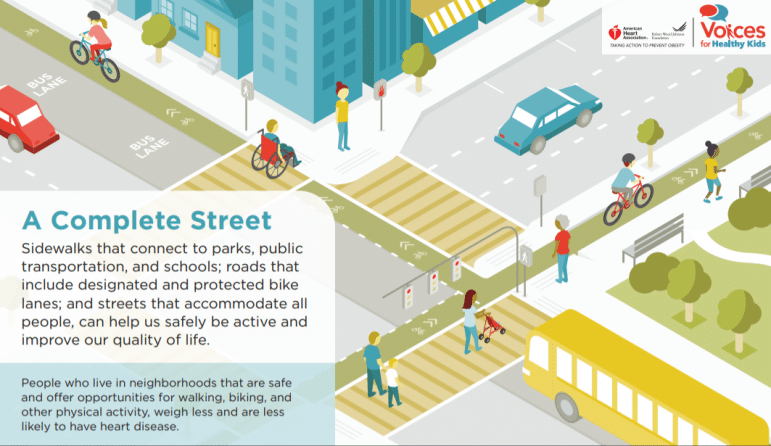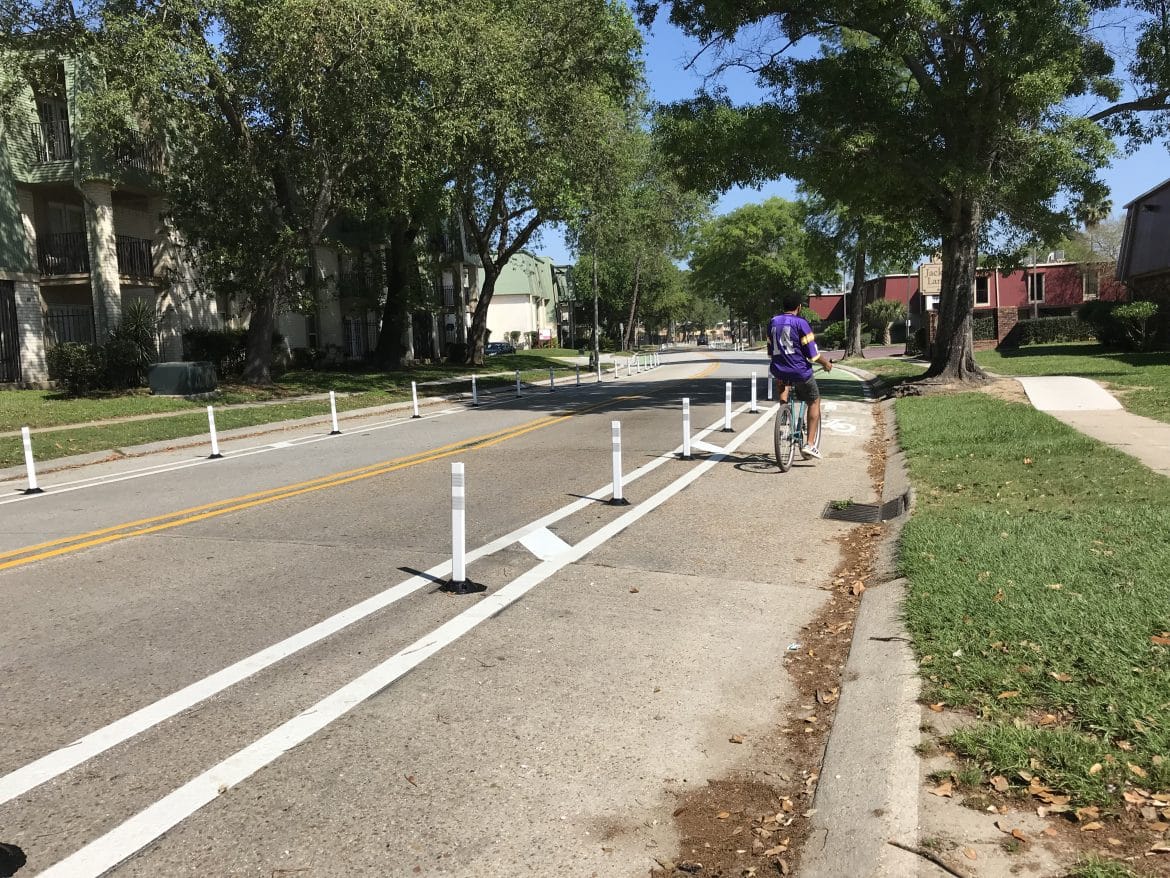
(via Moving New Orleans Bikes, Office of Transportation)
The city and the New Orleans Complete Streets Coalition, a group of organizations, businesses, civic leaders and community members, are on a mission to improve roadways and safe transportation options to enhance health, equity, sustainability, prosperity and quality of life in the city.
“It [NOCSC] really is focused on the fact that we as a coalition believe in constructing streets in a way that best accommodate all people safely and easily, no matter how they travel,” said Dan Favre, executive director of Bike Easy, a local bike advocacy and education program and a part of NOCSC. “Whether you’re someone driving, walking, riding a bike, taking transit or using a wheelchair or other mobility assistance devices, we really think that these streets are built to share.”
Through Moving New Orleans Bikes, a city initiative that began in April of last year that the NOCSC is heavily involved with, New Orleans is embarking on a city-wide bike planning effort, building low-stress bikeways in Central City, The Lower Garden District, Mid-City, Faubourg St. John, the 7th Ward, and the CBD.
Data used for construction planning include a bicycle equity index, which looks at where people are shown to have historic disadvantages when it comes to transportation, as well as technical aspects such as street sizes and speed limits. In addition to research and data, feedback from the community has also been incorporated.
“I think that when you’re looking at these types of changes on the roadways. It’s really important that people be part of the process,” Favre said, “thinking through and identifying the challenges and then also being given the chance to give feedback on the proposed solutions,
The city hosted a couple of rounds of public meetings and conversations, where NOSC members have presented collected feedback gathered through their own community engagement efforts. There have been community design meetings that discuss concept specifics of how streets will change and allowed questions and feedback from attendees, followed by pre-construction meetings that talk through received feedback, what could be accommodated, what couldn’t and why.
Chris Parker, a New Orleans native who has been commuting by bike in New Orleans for 25 years and is also an administrator of the Facebook group Bike Uneasy, regularly attended the public planning meetings.
Bike Uneasy does its part in keeping New Orleans streets safe by posting and documenting dangers toward New Orleans cyclists, such as hazardous roads and parked cars impeding their movement. At the public meetings, Parker was able to raise specific concerns from the group as well as some of his own.
For example, he said, during one meeting, he brought in an enlarged satellite image from Google Earth of South Carrollton Avenue to display how there is no safe way to get to Audubon Park straight down the avenue because the bike lane is interrupted for about a half a mile.
Parker says that the city has done a good initial broad-stroke job in terms of mapping and planning, and now appreciates the detail they are homing in on. Further, he thinks they are doing a good job implementing both research data and community feedback.
People For Bikes, a national biking advocacy group, agreed, giving New Orleans a score of 4 out of 5 in “acceleration,” which factors in advocacy, action and overall effort to ensure people’s biking safety.
Further, a recent ALG Research poll suggests that many residents are willing to accept trade-offs for safer streets and transportation options. For example, 81% of District B voters and 73% of voters city-wide said they were willing to have protected bike lanes that separate bicycles from car traffic, even if it means reducing roads with multiple lanes to one.
However, both Parker and Clark Thompson, another New Orleans native who has been biking in the city for 37 years and has followed the city’s plans, mention that the public meetings are often met with opposition from concerned residents with vehicles.
Thompson suggests that residents concerned about increased traffic in some areas should consider that safer options for alternative methods of transportation could mean fewer vehicles on the road and, ultimately, less traffic.
Parker’s message to residents concerned about lane reductions in some areas is that these changes aren’t only for residents with bikes; they are for everyone’s safety.
“Unless you have a driveway or managed to get a cool spot right in front of where you’re going, everyone’s a pedestrian at some point,” Parker said.

(via Complete Streets Coalition)
Farve adds an additional point in that more safe transportation options mean that more potential employees and consumers have access to businesses throughout New Orleans, which can help boost the city’s economy.
Miki Mendler, owner of Avenue Cafe on St. Charles Avenue, who has many employees and customers who bike to his shop, said that he has seen many accidents right outside of the shop. He adds that in the COVID-19 pandemic, with some reluctant to using public transportation for the foreseeable future, safe biking options are essential.
“Bikes would be a perfect replacement — it’s just so much faster. I mean, public transportation comes every hour,” he said. “If you have a bike, and it’s safe and it’s easy, that makes all the difference.” Depending on the route and the time of day, RTA buses generally are scheduled to run every 10 minutes to every hour.
Nearly 20% of households in New Orleans don’t have access to a car, and according to the ALG survey, most voters citywide (58%) say the lack of transportation options reduces quality of life.
Thompson adds that with existing food deserts throughout the city, safe and accessible transportation is a necessary responsibility for the city to provide to the community.
“I know that there’s an awful lot of people in New Orleans, that it’s very hard for them to get 20 blocks away,” he said. “If that’s a job or if that’s food for these people, we’ve got to provide a safe way for them to get to that job and to get to healthy food.”
Although community design and feedback meetings have already taken place, residents wanting to support or get involved with these initiatives are encouraged to visit the city’s site to view the bikeway blueprint and current proposals for Central City and the Lower Garden District and the CBD and Warehouse District.
Comments, questions and specific feedback can be emailed to movingneworleans@nola.gov. To learn more about NOCSC, visit nolacompetestreets.org.

so why when i walk down a street with bike lanes… and a bike guy is on the sidewalk..why should i step aside?